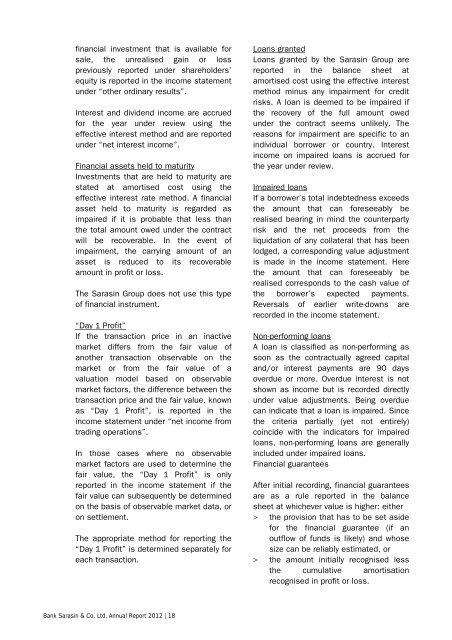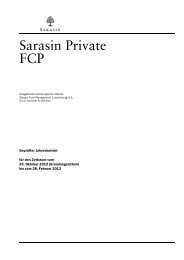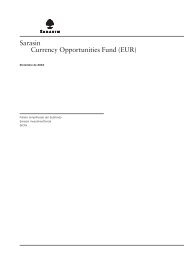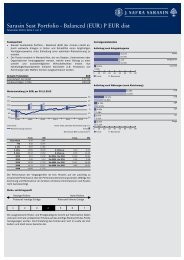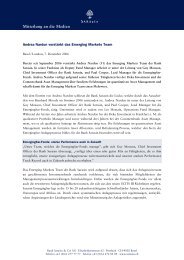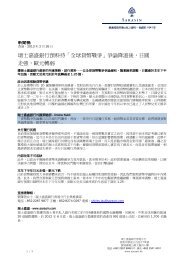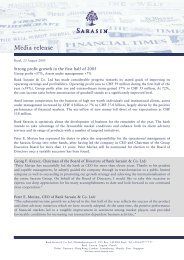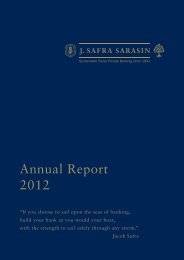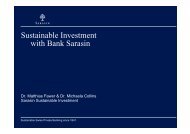Annual Report 2012 - Bank Sarasin
Annual Report 2012 - Bank Sarasin
Annual Report 2012 - Bank Sarasin
You also want an ePaper? Increase the reach of your titles
YUMPU automatically turns print PDFs into web optimized ePapers that Google loves.
financial investment that is available for<br />
sale, the unrealised gain or loss<br />
previously reported under shareholders’<br />
equity is reported in the income statement<br />
under “other ordinary results”.<br />
Interest and dividend income are accrued<br />
for the year under review using the<br />
effective interest method and are reported<br />
under “net interest income”.<br />
Financial assets held to maturity<br />
Investments that are held to maturity are<br />
stated at amortised cost using the<br />
effective interest rate method. A financial<br />
asset held to maturity is regarded as<br />
impaired if it is probable that less than<br />
the total amount owed under the contract<br />
will be recoverable. In the event of<br />
impairment, the carrying amount of an<br />
asset is reduced to its recoverable<br />
amount in profit or loss.<br />
The <strong>Sarasin</strong> Group does not use this type<br />
of financial instrument.<br />
“Day 1 Profit”<br />
If the transaction price in an inactive<br />
market differs from the fair value of<br />
another transaction observable on the<br />
market or from the fair value of a<br />
valuation model based on observable<br />
market factors, the difference between the<br />
transaction price and the fair value, known<br />
as “Day 1 Profit”, is reported in the<br />
income statement under “net income from<br />
trading operations”.<br />
In those cases where no observable<br />
market factors are used to determine the<br />
fair value, the “Day 1 Profit” is only<br />
reported in the income statement if the<br />
fair value can subsequently be determined<br />
on the basis of observable market data, or<br />
on settlement.<br />
The appropriate method for reporting the<br />
“Day 1 Profit” is determined separately for<br />
each transaction.<br />
Loans granted<br />
Loans granted by the <strong>Sarasin</strong> Group are<br />
reported in the balance sheet at<br />
amortised cost using the effective interest<br />
method minus any impairment for credit<br />
risks. A loan is deemed to be impaired if<br />
the recovery of the full amount owed<br />
under the contract seems unlikely. The<br />
reasons for impairment are specific to an<br />
individual borrower or country. Interest<br />
income on impaired loans is accrued for<br />
the year under review.<br />
Impaired loans<br />
If a borrower’s total indebtedness exceeds<br />
the amount that can foreseeably be<br />
realised bearing in mind the counterparty<br />
risk and the net proceeds from the<br />
liquidation of any collateral that has been<br />
lodged, a corresponding value adjustment<br />
is made in the income statement. Here<br />
the amount that can foreseeably be<br />
realised corresponds to the cash value of<br />
the borrower’s expected payments.<br />
Reversals of earlier write-downs are<br />
recorded in the income statement.<br />
Non-performing loans<br />
A loan is classified as non-performing as<br />
soon as the contractually agreed capital<br />
and/or interest payments are 90 days<br />
overdue or more. Overdue interest is not<br />
shown as income but is recorded directly<br />
under value adjustments. Being overdue<br />
can indicate that a loan is impaired. Since<br />
the criteria partially (yet not entirely)<br />
coincide with the indicators for impaired<br />
loans, non-performing loans are generally<br />
included under impaired loans.<br />
Financial guarantees<br />
After initial recording, financial guarantees<br />
are as a rule reported in the balance<br />
sheet at whichever value is higher: either<br />
> the provision that has to be set aside<br />
for the financial guarantee (if an<br />
outflow of funds is likely) and whose<br />
size can be reliably estimated, or<br />
> the amount initially recognised less<br />
the cumulative amortisation<br />
recognised in profit or loss.<br />
<strong>Bank</strong> <strong>Sarasin</strong> & Co. Ltd, <strong>Annual</strong> <strong>Report</strong> <strong>2012</strong> | 18


